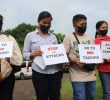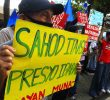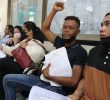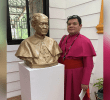A series of massacres of civilians in Sulu, including those of two grandchildren of an MNLF leader, provoked the latest wave of fighting between government troops and the Moro revolutionary group.
By Alexander Martin Remollino
Bulatlat.com
MANILA — Last Feb. 17, Moro National Liberation Front (MNLF) state chairman Khaid Ajibon sent two grandsons of his on an errand to the market in Indanan, Sulu. Upon their return, soldiers fired at them. One of the children was killed.
Eight days later, Scout Rangers bombarded the MNLF headquarters in Indanan, where Ajibon is based.
On April 25, Scout Rangers massacred a family of 10 in Timpuok, Patikul, Sulu. Only one of the family’s members managed to survive.
These incidents are what provoked the latest wave of fighting between the Armed Forces of the Philippines (AFP) and the MNLF, Bangsamoro People�s National Congress (BPNC) chairman Ustadz Zain Jali told Bulatlat in an interview this week.
�Because of these, (MNLF commander) Ustadz Habier Malik has had enough,� Jali said. �He cannot take these anymore.�
At around 6 a.m. on April 14, MNLF forces led by Malik attacked the detachment of the 11th Marine Battalion Landing Team in Tayungan, Panamao, Sulu. The assault left two soldiers dead and eight others wounded.
Before the series of massacres that provoked the latest wave of clashes, Malik and his men had �detained� a group led by Muslim convert Marine Maj. Gen. Benjamin Dolorfino in Jolo, Sulu. That was on Feb. 2-4.
Dolorfino, who also uses the name Ben Muhammad, went with Undersecretary for Peace Ramon Santos and 13 others to the MNLF�s Camp Jabal Ubod in Panamao, Sulu in the morning of Feb. 2 to talk with MNLF representatives headed by Malik. The group included two colonels, a junior officer, nine enlisted men, and several members of Santos� staff.
The talks were to tackle the holding of a tripartite meeting, proposed late last year by the MNLF, with the Government of the Republic of the Philippines (GRP) and the Organization of Islamic Conference.
In the afternoon of that same day, Dolorfino and his group were prevented from leaving the camp.
�General Dolorfino and his group were asked why the tripartite meeting had been postponed again, and Undersecretary Santos could not give any answer,� Jolo Councilor Cocoy Tulawie told Bulatlat in an earlier interview. �So they were prevented from leaving until the GRP and the OIC agreed to schedule a meeting for March 17.�
The proposed tripartite meeting was to tackle issues related to the 1996 Final Peace Agreement between the GRP and the MNLF.
The meeting scheduled for March 17 was to be a preliminary meeting in preparation for the tripartite meeting. �It didn�t push through,� Jali revealed.
The Armed Forces of the Philippines (AFP) is accusing the MNLF of coddling members of the bandit Abu Sayyaf Group (ASG) � an accusation that the Moro revolutionary group has vehemently denied.
�There is one group of people in Sulu tipping off others as �terrorists� or �terrorist coddlers� to the military, just for the bounty,� Jali disclosed. �That is why the military has these accusations against the MNLF.
Displacement
The fighting has displaced more than 40,000 civilians in Sulu. Some of the evacuees have been relocated at the Panglima Mamah Elementary School in Tagbak, Indanan, Sulu. The rest are in Jolo, the provincial capital � where there are no evacuation centers.
�There are no sanitary conditions (in the evacuation center),� Jali told Bulatlat. �The dangers of epidemics breaking out there are very high.�
In a separate interview, Moro-Christian People�s Alliance (MCPA) secretary-general Amirah Ali Lidasan confirmed this.
�Within the confines of the evacuation centers, the refugees catch different diseases,� Lidasan, who is also one of the nominees of the Suara Bangsamoro (Voice of the Moro People) Party, said. �And the food is never enough for all of them.�
Flashback
The MNLF traces its origins to a massacre of between 28 and 64 Moro fighters recruited by the government in 1968 for a scheme to occupy Sabah, an island near Mindanao to which the Philippines has a historic claim.
Sabah ended up in the hands of the Malaysian government during the presidency of Diosdado Macapagal (1961-1965). His successor Ferdinand Marcos conceived a scheme involving the recruitment of Moro fighters to occupy the island.
The recruits were summarily executed by their military superiors in 1968, in what is now known as the infamous Jabidah Massacre.
The Jabidah Massacre triggered widespread outrage among the Moros and led to the formation of the MNLF that same year. The MNLF waged an armed revolutionary struggle against the GRP for an independent Muslim state in Mindanao.
The Marcos government, weighed down by the costs of the Mindanao war, negotiated for peace and signed an agreement with the MNLF in Tripoli, Libya in the mid-1970s. The pact involved the grant of autonomy to the Mindanao Muslims.
Negotiations between the GRP and the MNLF went on and off until 1996, when the two parties signed a Final Peace Agreement which created the Autonomous Region of Muslim Mindanao (ARMM) as a concession to the group.
Sulu is one of four provinces under the ARMM: the others are Basilan, Maguindanao, and Tawi-Tawi.
In October 2001, hostilities broke out anew between the GRP and the MNLF. The military was in hot pursuit of Abu Sayyaf bandits who had abducted tourists in Sipadan, Malaysia. At one point, the military had announced the defeat of an �Abu Sayyaf� contingent in Talipao, Sulu.
The MNLF, however, said that it was its guerrillas, not Abu Sayyaf bandits, who were killed by the military.
The massacre in Talipao led the MNLF, just five years after signing a peace agreement with the government, to once more take up arms. MNLF founding chairman Nur Misuari, a former political science professor at the University of the Philippines (UP) who was then ARMM governor, said the Talipao Massacre was a �violation� of the 1996 Peace Agreement.
Misuari, who was then in Malaysia, ended up being arrested and subsequently detained in a military camp in Sta. Rosa, Laguna (38 kms south of Manila) and charged with rebellion. He is currently under house arrest in New Manila, Quezon City while still facing rebellion charges.
Since 2001, there has been sporadic fighting between the AFP and the MNLF. The waves of fighting have invariably been provoked by massacres of Moro civilians by soldiers, Jali said.
�Our people are always being massacred,� he said. (Bulatlat/davaotoday.com)
Peace Process









